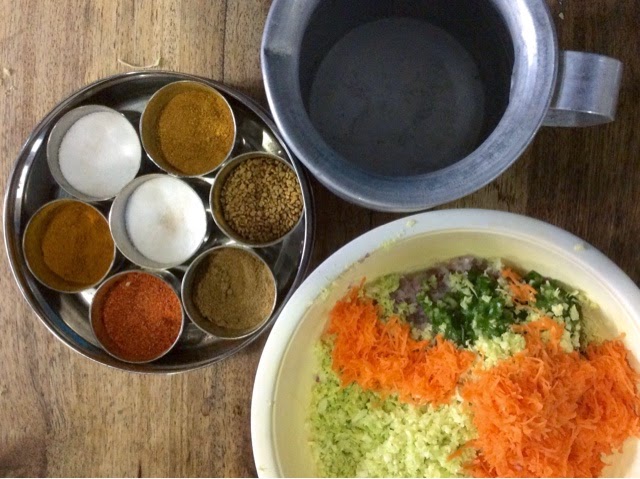We arrived into the 'land of smiles' as soon as we boarded Thai Airways - and what a massive smile we had when we met up with Nathan - one of Blandy's favourite ever people - in Bangkok. What a guy! For the past two months we've had fun meeting a lot of new people, but how awesomely special old friends are. As we had dinner near Khoa San Rd, minding our own business and savouring our authentic Pad Thai's, along came an older Thai gentleman and shoved a tray of nibbles under Bry's nose. Doing a double-take, Bry tried to compose herself, as it's not every day you see roasted scorpions on a skewer. The dark spindly legs looked rather ticklish, so we were polite and saved the entire tray for the next tourists.
A bit further down the road we stumbled across a trolley-cart-thing with a real decent menu of bugs and creepy critters. The delicacies were beautifully displayed, and came complete with a skewer for easy eating. For a dollar or so you could treat yourself to two inch long roaches, grasshoppers of the same length, or a tasty selection of larvae. The most eye catching and dry-wrench inducing were the palm sized hairy black spiders. Blandy "didn't have the right change," so we opted for the 10 baht (almost 50 cent) photo instead! If anyone's hoping for a souvenir, we think we're onto something here, so might pop back to one of the many bug trolleys and stock up.
Khoa San Rd is dubbed the epicentre of the backpacker world. We stayed on the street parallel, which was more packed and vibrant at 11pm than 11am. Nothing seemed out of place. A metler with long jet-black hair looked right at home. Hippy tie-died tshirts, beards and barefoot people sauntered up and down contentedly. Tons of 18 year olds on their first adventures filled the streets. Bangkok is old and young all at the same time. Calm and rowdy, frenetic and orderly (well, after Nepal, that is!). We were stoked to be able to breathe again without ingesting a lungful of dust and grime. Bry left Nepal with a rotten cough, sounding like she was bringing up half her insides with each raspy cough. So to breathe some half decent air again felt great ... we can only imagine what coming home to kiwi air will be like. And iceberg lettuce in a big juicy summer sandwich - that'd be yum! We caught the pic below on Khao San Rd, it's a veggie vending cart, chocka with as many types of vegetables as you can imagine.
The photo below shows a section of Khoa San Rd, we've purposefully left out the unsavoury ping pong ball pimps, who offer both males and females walking past a written menu of imaginative suggestions with their corresponding prices. A waiting taxi can whisk you away to experience a show at any time of the day or night. Bry very politely told one of the men 'no thank you' ... to which he asked 'why not?' ... We hope he understood when Bry sternly said 'because that's VERY rude.'
Hanging out with Nathan for the day, we went to Wat Po, the Recling Buddha (check out his size in the photos below), and some other temple that was ornate and had an amazing display of gold leaf sculptures. We're already a bit 'templed-out,' which is great because we can hit the Thai beaches uninterrupted during the next three weeks!
Within minutes of being at the tourist-packed shrines like the ones above, we were at a massive shopping mall, pictured below. Level upon level of mass produced, packaged products lined the shelves, which was highly contrasting to the past two months where all we'd seen was homemade and handmade items (along with bottled water, coke, chips, and other little convenience shop things). Being in a real supermarket again was buzzy, Bry was not a fan, and Blandy wanted to explore for hours. Supermarkets tell you a lot about a society.
Catching up with Nathan felt brilliant, and hearing about his adventures was pretty cool. It was impressive to hear him chatting away in Thai phrases, and we were glad for his insider knowledge of Bangkok. Nathan - thanks for being hilarious, thoughtful, a genuine gentleman and an adventurer. Hope you LOVE Bali.
Our second day in Bangkok was spent in a tuk tuk driven around madly by our pink-shirted friend Boss. We careened around corners and revved at red lights. Boss took us on a whistle-stop tour of a temple (we were easily distracted from yet another temple by a freaky looking water monitor in the stream nearby), we drove past the Royal palace, to the mandatory souvenir shop (Boss explained that he got a stamp if he brought tourists, and two stamps if they purchased something, he could later cash in the stamps for fuel), we took a quick look at the standing Buddha (who may have had too much sun, as he was peeling ... gold!), and to the mandatory tailor for another stamp or two.
























































